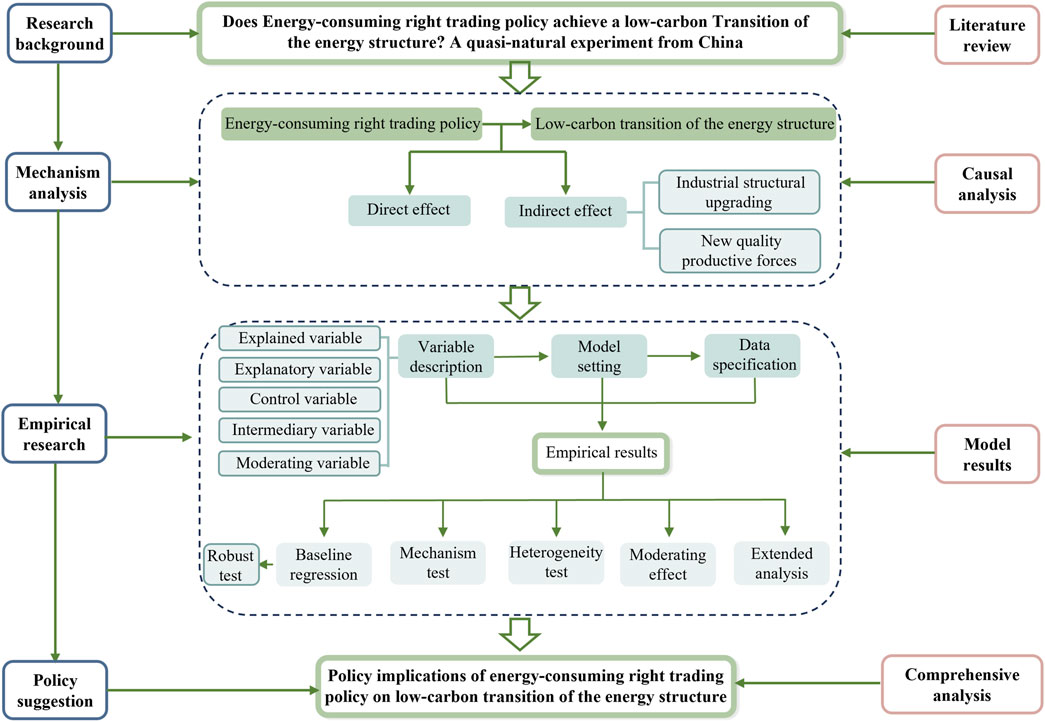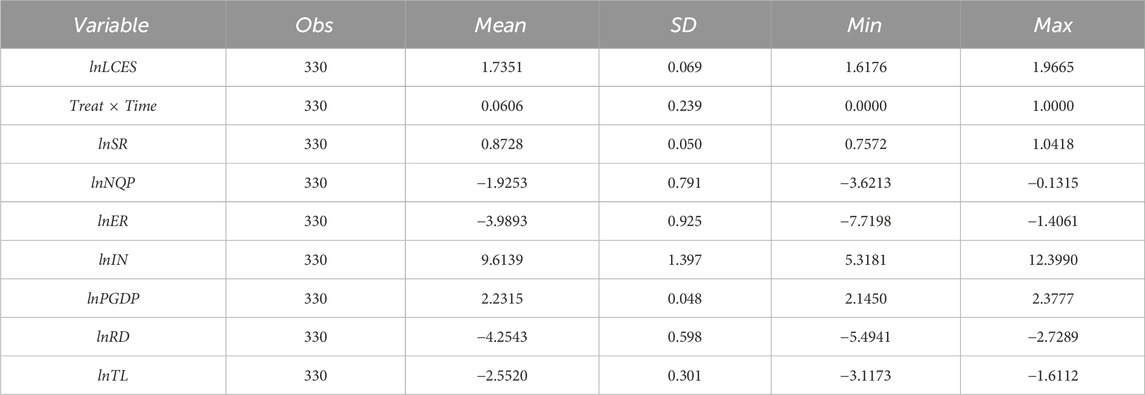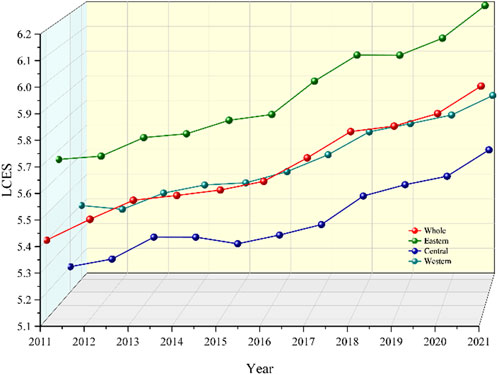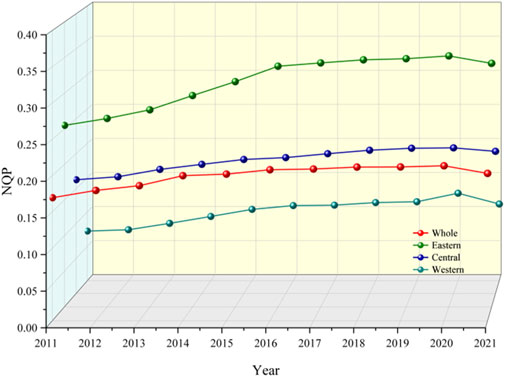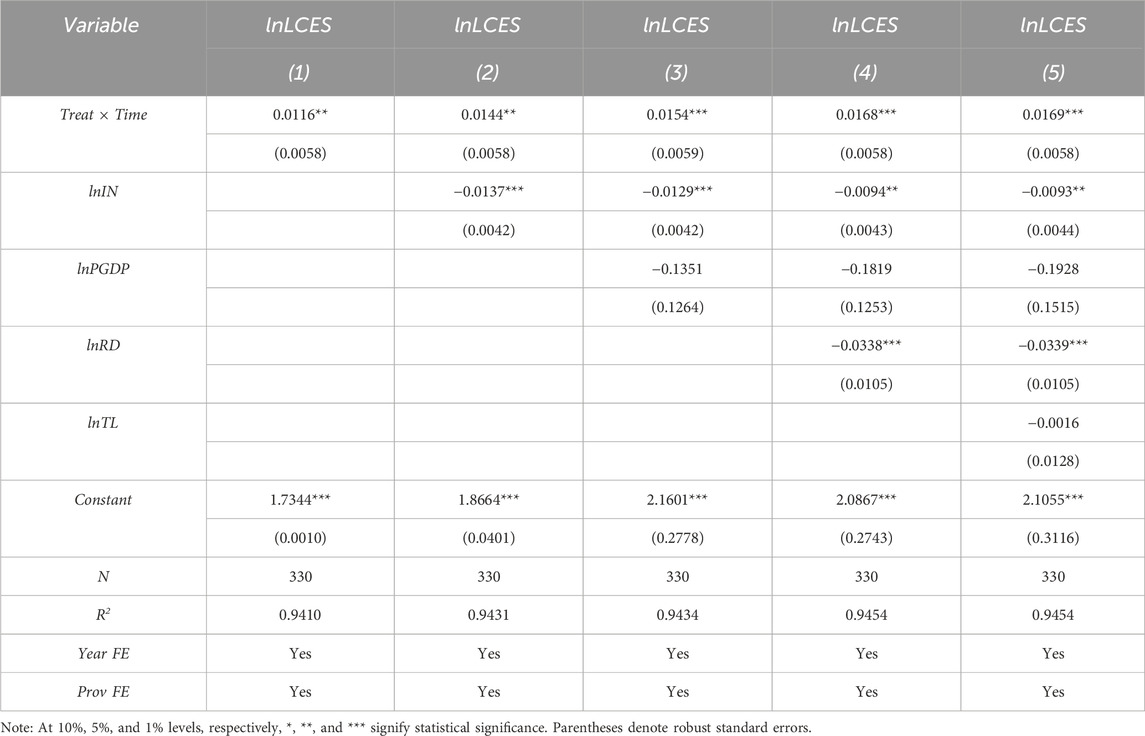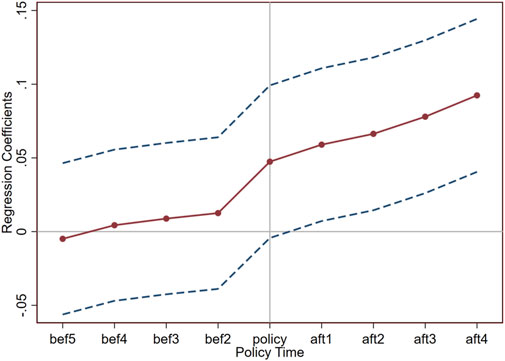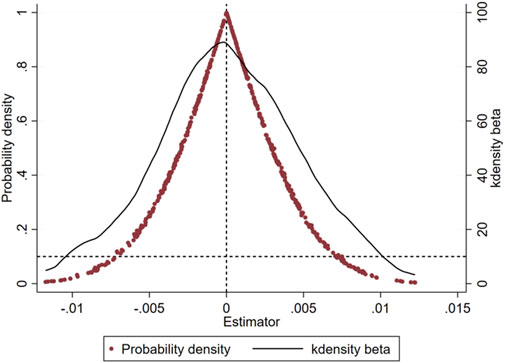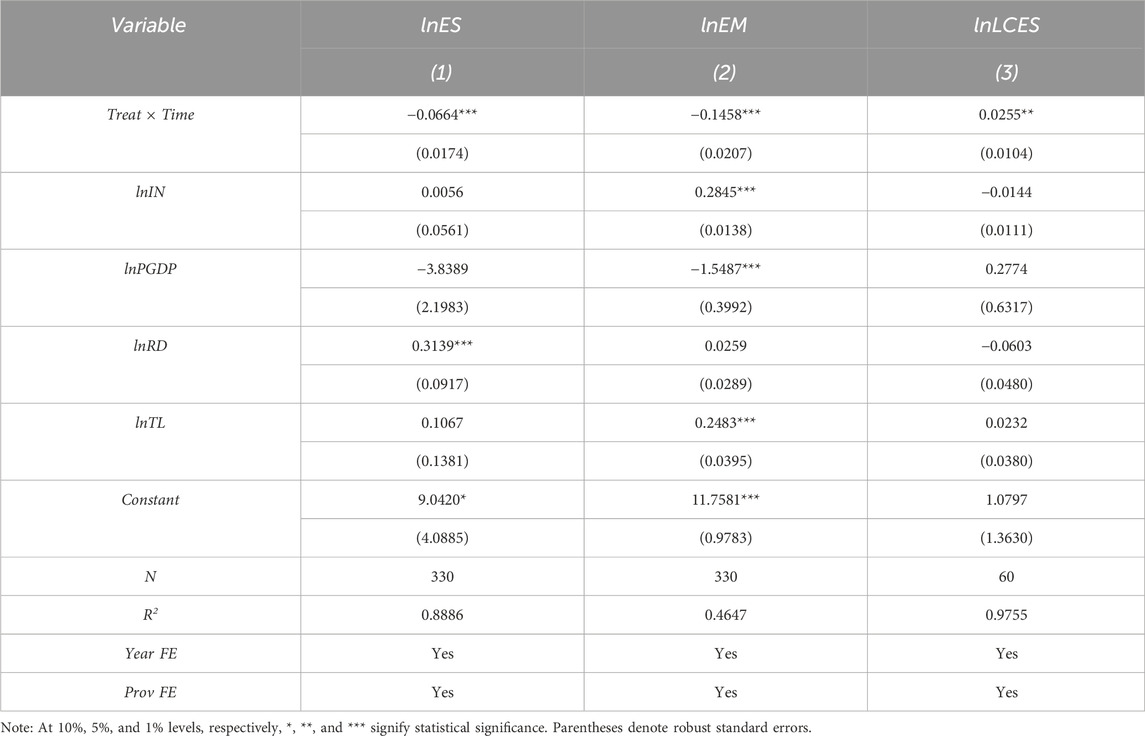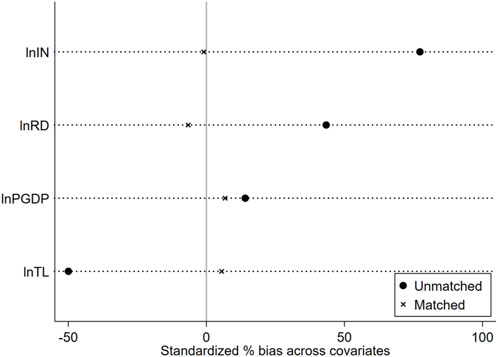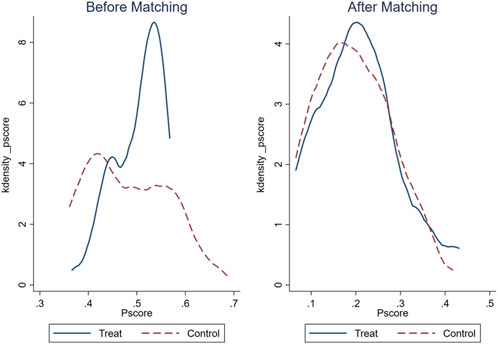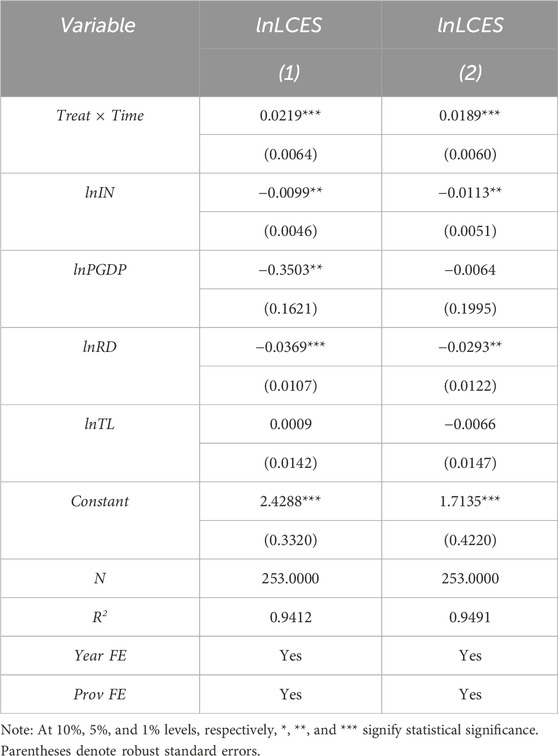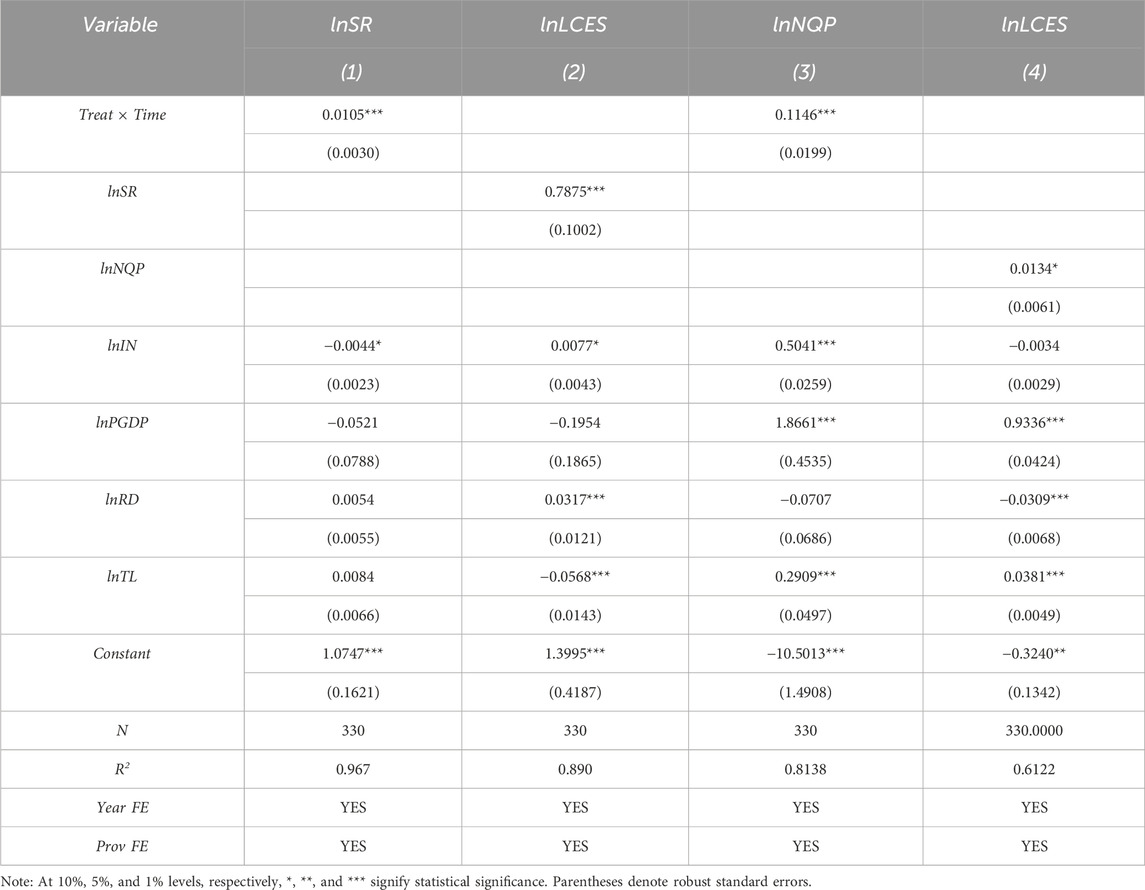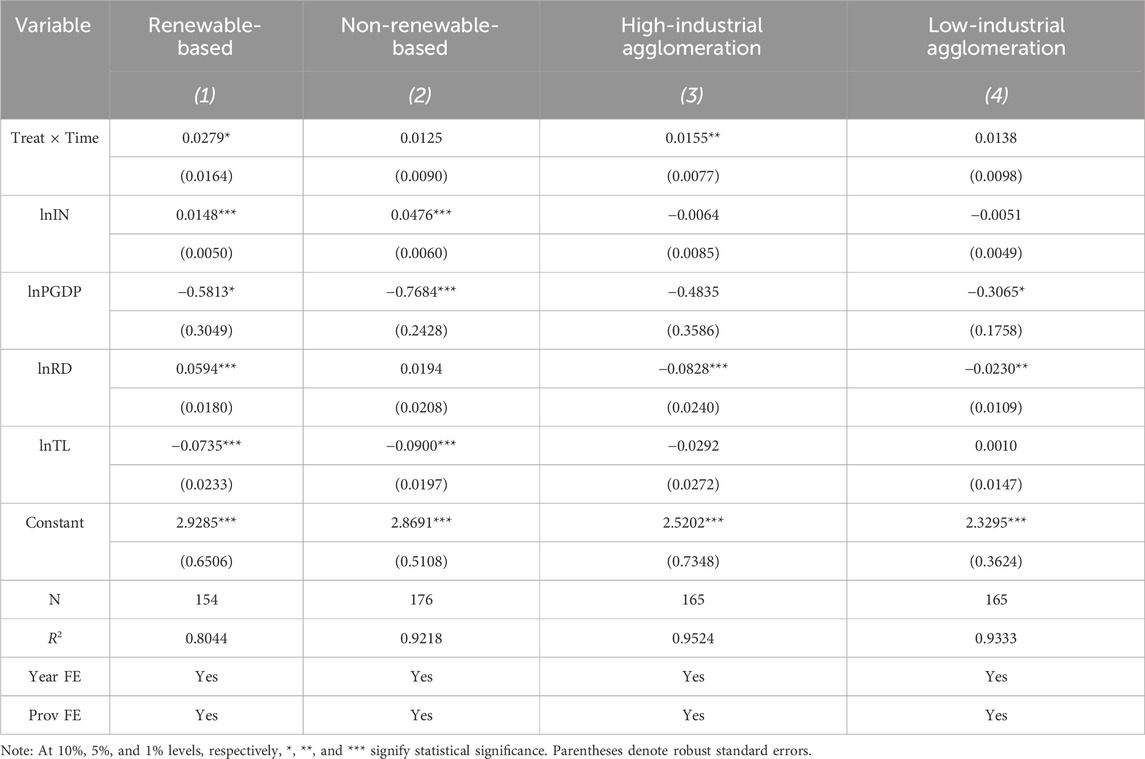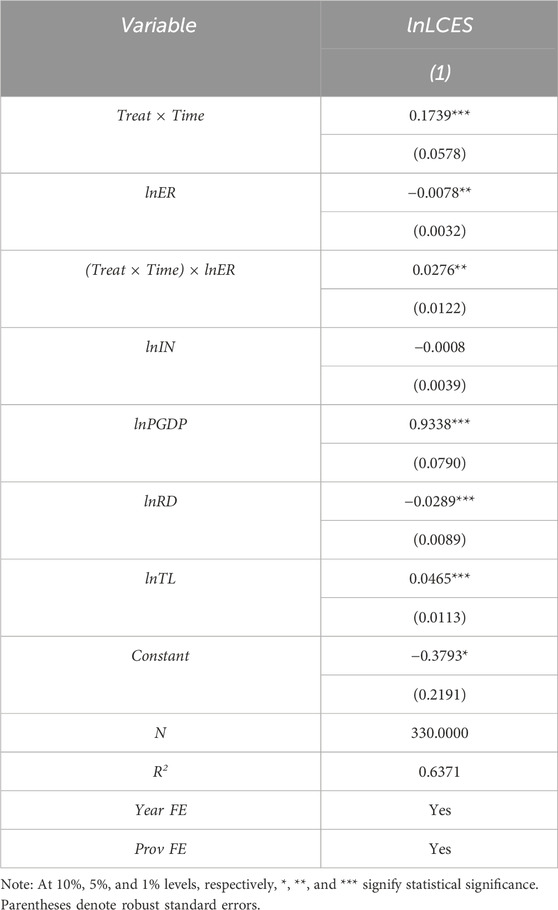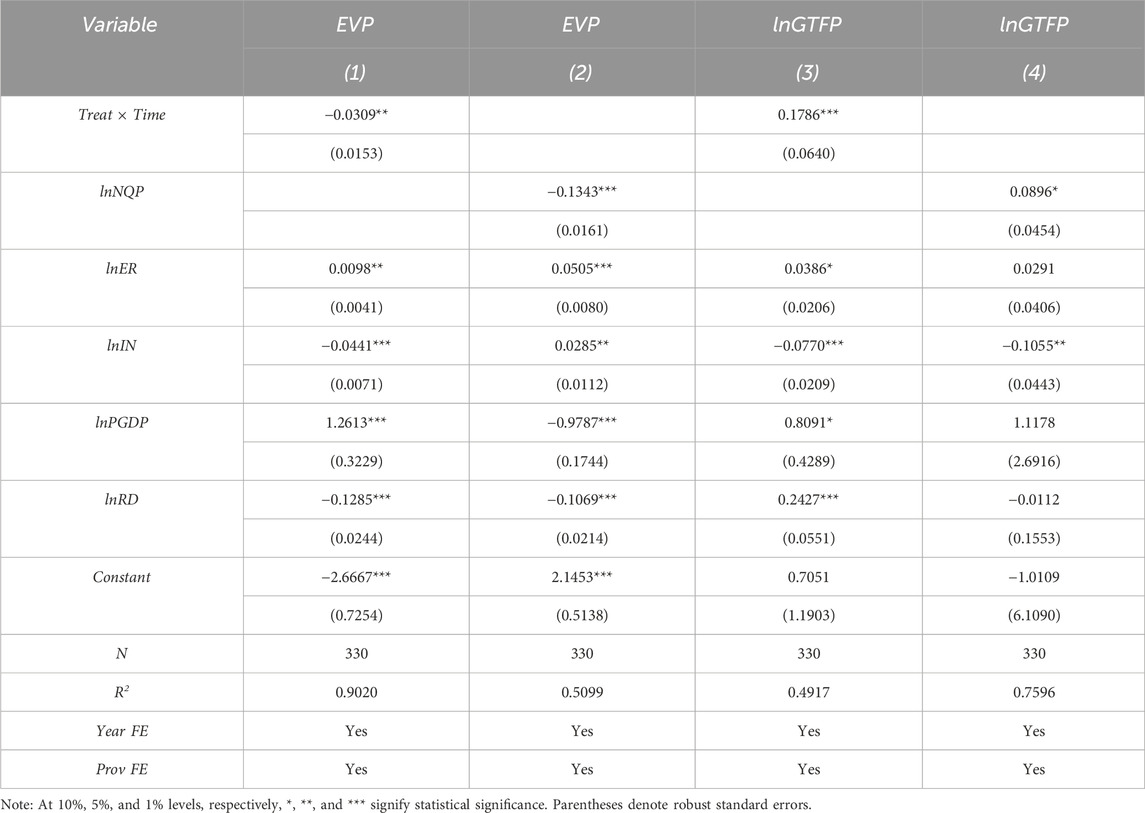- 1 Office of State-owned Assets Management and Procurement Bidding, Affiliated Hospital of Jiangsu University, Zhenjiang, China
- 2School of Economics and Management, Gannan University of Science and Technology, Ganzhou, China
- 3School of Humanities and Social Sciences, Jiangsu University of Science and Technology, Zhenjiang, China
Introduction: The implementation of energy-consuming right trading (ECRT) policy in 2017 is a major measure to promote the construction of ecological civilization and green development, which also aligns with the global trend towards sustainable energy management and carbon emission reduction.
Methods: Based on energy consumption data in China from 2010 to 2021, this paper utilizes the Difference-in-Differences (DID) method to assess the extent and process of the impact of energy consuming right trading policy on the low-carbon transition of the energy structure. The transmission mechanism of industrial structure upgrading and the new-quality productive forces in the impact process was discussed, and the regulatory role of environmental regulations was tested.
Results: The findings indicate: 1) ECRT has a strong driving effect on the low-carbon transition of the energy structure. 2) ECRT can promote low-carbon transition of the energy structure through the dual channel of promoting industrial structure upgrading and new quality productive forces. 3) The influence of ECRT on the low-carbon transition of the energy structure is different in different regions, and the higher degree of industrial agglomeration and renewable energy-rich regions are more significantly promoted by new quality productivity. 4) Environmental regulation has a significant positive moderating effect on the relationship between ECRT and low-carbon transition of the energy structure. 5) Furthermore, the exploratory analysis reveals that the positive impacts of ECRT policies on the low-carbon Transition of the energy structure translates into higher green total factor productivity and lower environmental pollution, which promotes the sustainable development of the low-carbon Transition of the energy structure.
Discussion: This paper responds to the basic question of whether energy use rights policies can promote the low-carbon Transition of the energy structure, and provides empirical evidence and policy reference not only for the development of China’s environmental policy and the direction of energy consumption but also for the international community’s efforts in sustainable energy and environmental governance.
1 Introduction
The motivation of the United Nations Sustainable Development Goals is for the whole world to join hands to address multiple challenges, focusing on ecological protection and energy transformation, and building a harmonious coexistence pattern to promote the all-round development of mankind and the sharing of wellbeing. Since reform and opening up, China has not only experienced rapid economic growth, but also a sharp rise in energy consumption and carbon emissions (Irfan et al., 2021). As a large energy-consuming country, coal accounts for the vast majority of China’s energy consumption. For a long time, China’s overreliance on and extensive consumption of traditional energy sources have resulted in a series of serious problems such as environmental pollution and resource exhaustion (Wang et al., 2021). Energy consumption and carbon emissions have increased sharply at the turn of the century (Green and Stern, 2017). According to the International Energy Agency (IEA), China has surpassed the United States as the largest carbon emitter in the world in 2007 (Li et al., 2021). To actively respond to global climate change, the Chinese government has established a series of emission reduction targets. Among them, the most important one is the “dual control” target: controlling carbon emissions and reaching carbon peaking. In 2009, the Chinese government made a commitment at the Copenhagen Global Climate Conference that by 2020, China’s carbon emissions per unit of gross domestic product (GDP) would be reduced by 40%–45% compared with 2005. In 2015, China submitted its Intended Nationally Determined Contributions (INDC) on combating climate change to the United Nations, announcing that it would reach the peak of carbon dioxide emissions around 2030 and reduce carbon dioxide emissions per unit of GDP by 60–65 percent compared with the 2005 level. For the realization of these goals, China has implemented systematic emission reduction measures. Nevertheless, China faces enormous pressure in carbon emission reduction. Currently, China’s economic development is highly reliant on coal, and the energy consumption structure is extremely unbalanced. The optimization and adjustment of the energy structure is a crucial force in promoting “carbon peaking and carbon emission reduction.” Increasing the development and utilization of green energy, reducing dependence on fossil energy, and promoting the development of the energy structure in a green, low-carbon, and sustainable direction have become an urgent need.
In this context, the Chinese government proposed to carry out pilot projects of paid use and trading of energy consumption rights in four provinces: Zhejiang, Fujian, Henan and Sichuan in 2016. Provinces actively implement the practice of ECRT, precisely define the scope of trading pilot projects, enhance platform construction, and validate price mechanisms. By the end of 2021, the Chinese government put forward further the policy of deepening the ECRT and strengthening its overall coordination and connection with carbon emission rights trading. In 2022, the Chinese government additionally pointed out that it is imperative to refine the regulation of total energy consumption and intensity. ECRT is designed to advance the market-oriented reform of resource elements and fully leverage the decisive role of the market in resource allocation, thereby establishing a powerful reverse mechanism. It spurs enterprises to enhance energy consumption management and effectively control their own energy consumption through various means. Consequently, it promotes the adjustment and upgrading of the energy structure and expedites the transformation of the development mode of energy consumption.
Globally, many countries are also facing similar challenges in energy consumption and carbon emissions. The European Union, for example, has been at the forefront of promoting renewable energy and carbon reduction policies. It has set ambitious targets for reducing greenhouse gas emissions and increasing the share of renewable energy in the energy mix, and has implemented a series of measures such as carbon trading schemes and strict environmental regulations. These policies have not only had a significant impact on the energy structure and economic development within the EU, but also provided valuable experience and reference for other countries. In addition, countries like the United Kingdom have made significant progress in phasing out coal-fired power plants and promoting the development of clean energy technologies. The United States, although its policies have fluctuated in recent years, also has a long history of research and practice in energy conservation and emission reduction technologies and policies.
As the ECRT becomes an important driving force for high-quality economic development and in response to the urgent requirements of climate change actions, exploring the contribution of ECRT to the low-carbon transformation of the energy structure can provide theoretical support for reasonably enhancing the government’s environmental regulatory capacity and promoting energy conservation and emission reduction. It can also contribute to the international community’s understanding and efforts in global climate change mitigation and energy structure optimization, allowing for more international cooperation and knowledge sharing in this area. The structure of this article is shown in the figure as follows Figure 1.
2 Literature foundation
2.1 Discussion on environmental policy
Environmental resources are the foundation for the survival and development of human society. They are public goods that are not exclusive but competitive, with serious externalities and are protected by environmental regulations. Therefore, this article divides global environmental policies into international environmental policies, national environmental policies, and regional environmental policies according to their effectiveness for discussion respectively.
2.1.1 International environmental policies
International environmental policies address a range of environmental issues, including biodiversity loss, climate change, and pollution. Through international conventions and agreements, countries cooperate to set goals, develop strategies to address environmental threats, and establish regulations. International environmental regulations include: The United Nations Framework Convention on Climate Change (UNFCCC), which was adopted in 1992 and has been ratified by almost all countries. It has laid the legal foundation for international cooperation in addressing climate change and is an authoritative, universal, and comprehensive international framework (Awewomom et al., 2024). The United Nations Convention to Combat Desertification (UNCCD) was adopted in Paris, France on 17 June 1994. It is the vision and spokesperson for the global land and aims to promote strengthened cooperation among the international community in combating desertification and alleviating the impacts of drought (Dooley, 2002). The Convention on Biological Diversity (CBD) is a legally binding international treaty with three main objectives: conserving biological diversity, sustainably using biological diversity, and sharing the benefits arising from the utilization of genetic resources in a fair and equitable way (Normile, 2010). The UNFCCC, the UNCCD and the CBD are collectively known as the “Rio Conventions.” The Kyoto Protocol is a branch of the United Nations Framework Convention on Climate Change (UNFCCC). It commits industrialized countries and economies in transition to limit and reduce greenhouse gas (GHG) emissions in accordance with agreed specific targets and implements the United Nations Framework Convention on Climate Change (Depledge, 2022). The Paris Agreement came into force on 4 November 2016. It is a legally binding international treaty and marks the beginning of a transition to a world of net zero emissions (Meinshausen et al., 2022). These environmental regulatory policies play a crucial role in preventing global pollution, promoting sustainable development, and protecting natural resources. At present, the international environment is complex and volatile, which has a great impact on environmental issues. Conducting international cooperation is an effective way to address these challenges. The establishment of the United Nations Environment Agency has generally promoted international cooperation and the emergence of international law (Perrez, 2020). However, there are some countries that may raise objections to the environmental regulatory policies of the United Nations. For instance, Pallemaerts M criticizes that international environmental law subordinates environmental policy obligations to economic development policies, thereby reflecting the triumph of unrestrained anthropocentrism (Pallemaerts, 1992).
2.1.2 National environmental policies
Countries formulate environmental policies according to national geographical locations, economic structures and priorities, etc., including a series of regulations, laws and plans that are conducive to reducing environmental pollution, maintaining ecological balance and promoting sustainable development (Assamoi and Wang, 2023). National environmental policies include: In 2018, the British government promulgated “A Green Future: Our 25 Year Plan to Improve the Environment,” which clarifies the actions and measures of the British government to help restore the natural environment and maintain the health of the people (HM Government, 2018). In 2021, the government announced the “Net Zero Strategy,” detailing a series of measures to help the country achieve net zero emissions by 2050 (HM Government, 2021). As the environmental protection authority of the U.S. government, the United States Environmental Protection Agency (USEPA) undertakes responsibilities such as formulating and implementing environmental protection policies, monitoring and evaluating environmental conditions, formulating environmental standards and regulations, enforcing laws and supervision, as well as environmental research and technical support (Anastas and Zimmerman, 2021). As the largest developing country in the world, along with economic development, social progress and the improvement of public environmental awareness, China has adopted policies to protect the environment, implemented the sustainable development strategy and explored a new path of giving priority to ecology and green development (Zhang et al., 2024).
2.1.3 Regional environmental policies
Regional environmental policies have exerted a remarkable influence in alleviating pollution issues across different regions by means of comprehensive international cooperation and the construction of a unified environmental management system among partner countries. This transnational cooperation mechanism has notably enhanced the processing efficiency in addressing regional environmental problems. Regional environmental policies frequently give rise to the establishment of regional agreements, norms and standards that are designed to curtail pollution emissions, restrain waste migration, enhance resource utilization efficiency and preserve biodiversity. These environmental policies create a system of resource sharing and cooperation for participating countries and jointly assume the collective responsibility for environmental protection and sustainable development within the region (Yang et al., 2023). According to the reports of ASEAN countries in their Voluntary National Reviews (VNRs), some countries have promulgated many environmental policies on achieving the Sustainable Development Goals. However, the main reasons for the insufficient progress of ASEAN countries in the environmental dimension of the Sustainable Development Goals are insufficient environmental policies or insufficient attention to the Sustainable Development Goals (Elder and Ellis, 2023). The formulation of European forest policies is influenced by the process of European integration. After the European Commission launched the new “EU Biodiversity Strategy for 2030” and the new “EU Forest Strategy,” the polarization between the environment and forestry and land use alliances is still continuing. However, the introduction of these environmental policies has injected vitality into restoring the health of the natural environment, protecting wild animals and plants, creating new economic opportunities and improving the quality of life of the people of the European Union (Sotirov et al., 2021).
2.2 Influencing factors of energy structure
At present, there are relatively few literatures on energy structure research, and most of these literatures focus on the relationship between energy consumption and its influencing factors (Oteng-Abayie and Mensah, 2024; Zou and Chau, 2006). Regarding the influencing factors of energy structure transformation, existing research mainly analyzes from two levels: internal structure and external regulation. First, for internal structural factors, climate financing and the development of innovative technologies accelerate the commercialization of promising clean technologies in the medium term, increase energy self-sufficiency, and reduce the proportion of coal in terminal consumption, thereby inhibiting the transformation of an energy structure dominated by coal (Warren, 2020). Industrial agglomeration brings economies of scale and agglomeration effects. Through resource sharing within the region, it improves energy utilization efficiency, promotes energy conservation and emission reduction, and then promotes the low-carbon transformation of the energy structure (Lin and Zhu, 2017). However, in the traditional industrial structure, the increase in the output value of high-energy-consuming industries and backward production management equipment will lead to a reduction in energy utilization efficiency, which is not conducive to the low-carbon transformation of the energy structure (Xia and Wang, 2020). Second, for external regulatory factors, the policy environment is one of the internal driving forces to promote the transformation of the energy structure (Bai et al., 2023; Jia et al., 2024; Su and Tan, 2023). Differentiated environmental policies will have different impacts on energy consumption (Jia et al., 2024). The implementation of carbon trading policies can improve energy utilization efficiency and solve the problem of energy structure transformation (Hong et al., 2022). However, the policies of some countries and regions may trigger a green paradox, thus producing unexpected adverse consequences (Grafton et al., 2014).
In conclusion, scholars have conducted multi-dimensional analyses of environmental policies and energy structures and achieved relatively fruitful results. However, at present, there are relatively few studies on the relationship between environmental policies and energy structures. Based on this, from the perspective of ECRT, we study its mechanism of action on the energy structure. By employing the entropy method and the benchmark regression model and selecting panel data of 30 provinces (including municipalities directly under the central government) in China, we measure the energy structure. We empirically test the impact of energy consumption rights policies on the low-carbonization of the energy structure and put forward suggestions to promote the low-carbon transformation of the energy structure. The possible marginal contributions are as follows: First, quantitatively measure the low-carbonization of the energy structure from an empirical perspective and study the specific impact of energy consumption rights policies on the low-carbon transition of the energy structure, in order to provide a reference for promoting the development of energy-consuming rights trading policy and the low-carbon transformation of the energy structure. Second, this study delves into the mechanism through which industrial structure upgrading and new-quality productive forces play a role in promoting the low-carbon transformation of the energy structure under energy consumption rights policies. Additionally, it examines the moderating effect of environmental regulations, thereby providing a foundation for formulating effective industrial and energy policies. Third, undertake a heterogeneity analysis grounded in the degree of industrial agglomeration and renewable energy endowment. This analysis aims to unveil the disparities in the impact of energy consumption rights policies on the low-carbon transformation of the energy structure under diverse circumstances, thereby offering a reference for the precise implementation of regional policies.
3 Theoretical analysis and research hypothesis
3.1 Energy-consuming rights trading policy and energy structure
The energy-consuming rights trading policy assists in promoting the low-carbon transformation of the energy structure by promoting the intelligent and efficient use of energy (Zhang et al., 2023). Energy is the foundation of human social development and economic operation. However, the traditional energy supply model faces many problems such as environmental pollution, resource depletion and carbon emissions (Guo et al., 2024a). In this context, the proposal of the energy-consuming rights trading policy provides new opportunities and impetus for the low-carbon transformation in the energy field. According to Porter’s hypothesis, the energy consumption right trading system will promote technological innovation (America’s Green Strategy, 1991). New technologies including artificial intelligence, big data analysis, the Internet of Things, and blockchain are all within the realm of technological innovation. Their rapid development and application are driving the transformation and upgrading of traditional industries and attracting numerous high-end talents and enterprises to invest and cluster. This process also exerts a revolutionary impact on the energy sector. The application of artificial intelligence technology in the energy field, through establishing an accurate energy consumption relationship system, not only enables energy consumers to have a better understanding of energy consumption but also realizes efficient energy distribution and intelligent scheduling, thus improving the energy structure. With the assistance of the Internet of Things and big data analysis, an intelligent energy network is established to facilitate the large-scale utilization of renewable energy. Meanwhile, as human understanding of nature and the level of scientific and technological innovation grow, enterprises can develop more advanced and efficient new materials and new energy sources, thereby reducing reliance on limited resources and promoting the optimization and adjustment of the energy structure. Therefore, the formation and development of the energy-consuming right trading policy will have a direct influence on the low-carbon transformation of the energy structure. Based on the above analysis, a research hypothesis is put forward.
H1:. The energy-consuming right trading policy can promote the low-carbon transformation of the energy structure.
3.2 The mediating role of industrial structural upgrading
The energy-consuming right trading policy centers on industries. Through the application of new technologies, new processes and new models, it drives the upgrading of industrial structure and facilitates the transformation of traditional industries into emerging industries with high added value and efficient energy utilization (Liu et al., 2020). Consequently, it provides the necessary technical conditions and industrial space for the transformation of energy structure. In the context of the rapid iterative upgrading of technology, a series of emerging industries with long-term development orientations, such as intelligent manufacturing, new materials, and environmental protection equipment, have come into being, unleashing tremendous development potential and facilitating the continuous upgrading of industrial structure and high-quality economic development. Meanwhile, the upgrading of industrial structure reduces the demand for coal in energy at the production end, cuts down carbon emissions and propels the transformation of energy structure. Specifically, as new energy technologies achieve continuous breakthroughs, the corresponding industrial chains also emerge and grow. These burgeoning industries can not only optimize the traditional industrial structure but also stimulate the development of related ancillary industries such as equipment manufacturing, energy storage, and smart grids, thereby forming a complete new energy industry system and offering crucial support for the low-carbon transformation of the energy structure (Yang et al., 2024). Based on the above analysis, a research hypothesis is put forward.
H2:. The energy-consuming right trading policy promotes the low-carbon transformation of the energy structure by promoting the upgrading of industrial structure.
3.3 The mediating role of new quality productive forces
The energy-consuming right trading policy offers substantial support for the development of new-quality productive forces by stimulating enterprises’ internal impetus for energy conservation and consumption reduction through market mechanisms. New-quality productive forces are complex productive forces with scientific and technological innovation as the fundamental driving force and are characterized by the enhancement of labor productivity, the expansion of division of labor, product innovation, and the all-round and free development of people. They are a new type of productive force with an endogenous dynamic mechanism and continuously increasing sustainability (Li et al., 2024). New quality productive forces have promoted the emergence of new technologies such as artificial intelligence, big data, and 5G. These new technologies can improve production efficiency, optimize industrial chains, create new business models, and enhance resource utilization efficiency and green technology innovation capabilities (Liu and He, 2024). New quality productive forces promote the agglomeration of elements such as finance, technology, and human resources, and promote the formation and development of emerging industrial chains, thereby promoting green technology improvement and production process optimization among each other (Guo et al., 2024b; Wang et al., 2024a). New-quality productive forces improve total factor productivity and reduce environmental pollution by strengthening the efficient flow and sharing of information, technology, talents, and resources (Li and Liu, 2024). Therefore, the energy-consuming right trading policy can help build a new low-carbon, efficient and coordinated energy production and consumption system by promoting new-quality productive forces, thus providing solid support for the low-carbon transformation of the energy structure. Based on the above analysis, a research hypothesis is proposed.
H3:. The energy-consuming right trading system promotes the low-carbon transformation of the energy structure by promoting new-quality productive forces.
4 Research design
4.1 Model setting
To investigate the influence of the energy-consuming right policy on the low-carbon transformation of the energy structure, this article sets up the following regression model.
In this context,
4.2 Variable description
4.2.1 Explained variable
Low-carbonization of energy structure (
First, the consumed energy is divided into three categories: coal, oil and gas, and other energy consumption. The consumption proportion of each type of energy in year
Second, calculate the included angles
Finally, weight all the vector included angles in year
4.2.2 Explanatory variable
The dummy variable of ECRT (
4.2.3 Intermediary variable
Industrial structure upgrading (
New quality productive forces (
4.2.4 Moderating variable
Environmental regulation (
4.2.5 Control variable
Referring to the practice of Guo et al. (2024d), this paper selects a series of control variables that may affect the low-carbon transformation of energy structure, specifically including: innovation level (
4.3 Data sources and descriptive statistics
This study employs balanced panel data of 30 provinces in China (excluding Hong Kong, Macao, Taiwan, and Tibet) from 2010 to 2021 to investigate the impact of the initiation of ECRT in 2017 on the low-carbon transformation of regional energy structure. The data sources are the Statistical Yearbooks of China over the years, statistical yearbooks of various provinces, etc. Missing values are filled by interpolation. To eliminate heteroscedasticity in the data and make it more stable, after taking logarithms of all variables, the descriptive statistical information of each observed variable is as shown in Table 1.
4.4 Analysis of calculation results
4.4.1 The level of low-carbonization of energy structure
According to Formulas 2–4, the changing trend of the average value of low-carbonization of energy structure in the whole country and major regions is shown in Figure 2. The level of low-carbonization of energy structure presents a pattern of “Eastern > Western > Central.” As the economic and technological innovation center of China, the eastern region is home to more research and development institutions and high-tech enterprises. It can absorb and apply new energy technologies more rapidly, thus promoting the low-carbonization process of the energy structure. Although the overall economic level of the central region is higher than that of the western region, the industrial structure of the central region is more reliant on traditional energy sources and faces greater pressure in industrial transformation and upgrading as well as low-carbon development. In contrast, the western region is abundant in energy sources such as solar energy, wind energy, and geothermal energy. Under the guidance of the national low-carbon development strategy, more emphasis will be placed on developing local renewable energy to achieve a win-win situation between economic development and environmental protection (Liu et al., 2024).
4.4.2 Level of new quality productive forces
According to the aforementioned approach, the evaluation scores of new-quality productive forces for 30 provinces (including municipalities directly under the central government) are calculated. The trend of the average value of new-quality productive forces in the whole country and the three major regions is depicted in Figure 3. In terms of regional distribution, the level of new-quality productive forces exhibits a pattern of “Eastern > Central > Western.” The development level of new-quality productive forces in the eastern region is higher than the national average. Firstly, the economic foundation is one of the fundamental causes for this regional disparity. Benefiting from the unique geographical advantages of the eastern region and the early implementation of reform and opening-up policies, it has amassed abundant capital and technological resources. The higher social productivity and consumption level also provide solid economic support for the transformation and application of new-quality productive forces, endowing the eastern region with a distinct advantage in the initial accumulation of new-quality productive forces. In contrast, due to geographical location and historical reasons, the economic development of the central and western regions started relatively late, and their capital accumulation and technological foundation are relatively weak.
Secondly, scientific and technological innovation capabilities also have a significant impact on regional differences in new quality productive forces. The eastern region concentrates China’s first-class universities and scientific research institutions. For instance, Zhongguancun Science and Technology Park in Beijing and Zhangjiang High-tech Park in Shanghai. These places gather a large number of scientific research resources and form a good innovation ecosystem. High-level scientific research activities and a large number of innovative enterprises accelerate the transformation and application of technological achievements, thereby promoting the formation and development of new-quality productive forces. In contrast, the central and western regions relatively lack such scientific and technological engines. The scarcity of scientific research resources limits the development speed of their new quality productive forces.
Finally, varying degrees of openness to the outside world result in different speeds of acquiring international advanced technologies and management experience. The eastern region, due to its high degree of openness in the early stage and close connection with the international market, has absorbed a large amount of advanced technology and management experience through means such as introducing foreign capital and engaging in international cooperation. This provides external support for the improvement of its level of new-quality productive forces. However, due to historical and geographical factors, the central and western regions have relatively low levels of openness and insufficient degrees of internationalization, which limits their ability to obtain external resources and advanced technologies.
In terms of growth rate, the national level of new-quality productive forces is growing rapidly. It increased from 5.4795 in 2011 to 5.9858 in 2021, an increase of 1.09 times. Among them, the level of new-quality productive forces declined from 2020 to 2021. Considering that the epidemic has had a severe impact on the Chinese economy, production activities in some regions are restricted, and enterprise production and operation are also greatly affected.
5 Empirical results and analysis
5.1 Baseline regression
This paper conducts a regression on the baseline regression Formula 1. Table 2 reports the regression results of ECRT on the low-carbonization of energy structure. Among them, column (1) only controls the fixed effects of province and year. The interaction coefficient is 0.0116 and passes the significance test at 5%. Columns (2) to (5) sequentially add control variables on the basis of column (1). After controlling other influencing factors, the estimated coefficients of the core explanatory variable
5.2 Parallel trend test
The application of the difference-in-differences method necessitates fulfilling the parallel trend assumption. That is, before the introduction of ECRT, there should not be any systematic disparity in the low-carbon transformation of energy structure between pilot areas and non-pilot areas. Hence, this paper conducts a parallel trend test by drawing on the event study method proposed by Jacobson et al. (1992) Taking 2016, the year prior to the introduction of ECRT, as the base year, it examines the changes in effects of each year before and after the introduction of the pilot policy. The test results are shown in Figure 4. The results indicate that in the years before the introduction of ECRT, there is no significant difference in the low-carbon level of energy structure between pilot areas and non-pilot areas. After the policy is introduced, the low-carbon level of energy structure in pilot areas is significantly higher than that in non-pilot areas. Thus, the parallel trend test is passed.
5.3 Robustness test
The main sources of endogeneity issues include variable measurement errors, omitted variables, and reverse causality. In the case of this paper, there is little need to be overly concerned about the reverse causality problem. Since the explained variable is the low-carbonization level of the energy structure of individual provinces at the micro level, and the core explanatory variable is a dummy variable for macro policies. The introduction of ECRT is determined by the Chinese government and is less influenced by individual provinces and regions. Therefore, the core conclusion of this paper will not be unduly disrupted by the reverse causality problem. In this section, robustness tests will mainly be conducted focusing on variable measurement errors and omitted variable issues.
5.3.1 Placebo test
Based on the passing of the parallel trend test, this paper conducts a placebo test to further examine to what extent the benchmark regression results are disturbed by random factors and omitted variable problems. In this study, through random sampling, the experimental group is randomly assigned to the entire sample for a placebo test. This operation is repeated 1000 times to improve the validity of the test. Figure 5 shows the scatter distribution of the probability density distribution of the synergistic estimation. The synergistic estimation of the placebo test is concentrated around 0, and most of them are not significant. The estimation results of the benchmark regression are not included in the test results. This indicates that the conclusion of this study is not affected by other unobserved variables.
5.3.2 Replace the measurement method of the explained variable
To mitigate the possible endogeneity issue arising from variable measurement errors, this paper selects two indicators, namely, carbon emissions and energy structure, and reconstructs the proxy indicator for the low-carbonization of energy structure before conducting sequential regressions. Specifically, carbon emissions (lnEM) are measured by taking the logarithm of the total combined carbon emissions within three scopes. Scope 1 refers to all direct emissions within the urban jurisdiction, mainly encompassing greenhouse gas emissions from transportation and buildings, industrial production processes, agriculture, forestry and land use changes, and waste disposal activities. Scope 2 pertains to indirect emissions related to energy that occur outside the urban jurisdiction, primarily including emissions generated by purchased electricity, heating, and/or cooling to meet urban consumption. Scope 3 denotes other indirect emissions caused by internal urban activities and occurring outside the jurisdiction but not included in Scope 2, which comprises greenhouse gas emissions from the production, transportation, use, and waste disposal of all items purchased by cities from outside the jurisdiction. Energy structure (lnES) is measured by calculating the proportion of coal in the energy structure. The regression results are presented in columns (1) and (2) of Table 3. In these two regressions, the regression coefficient of
5.3.3 Propensity score matching-difference in differences method (PSM-DID)
The differences in development levels among different provinces may lead to a sample selection bias problem in the benchmark regression structure of this paper. In order to better select control group regions, this part will use PSM-DID to enhance the comparability between pilot areas and non-pilot areas. The covariates are the control variables in the benchmark regression of this paper. Through Logit regression, the probability of each region becoming an experimental area is predicted. Then, the nearest neighbor 1:1 matching method is used to match the control group for the experimental group samples, thereby reducing the endogeneity problem caused by the self-selection bias of ECRT when it is established. Finally, DID regression is performed based on the matched samples. The PSM balance test chart is shown in Figure 6. The results show that the sample deviation between the treatment group and the control group is significantly reduced after matching, indicating that the matching effect is relatively ideal. At the same time, this paper also further examines the matching effect of the experimental group and the control group through the probability distribution density function diagram of propensity score values. Figure 7 shows that the probability density distribution of propensity score values of the experimental group and the control group after matching is closer than before matching, indicating that the matching effect is good.
Column (3) of Table 3 shows the regression results of PSM-DID. The results show that the regression coefficient of
5.3.4 Exclude the interference of important environmental policies
In 2013 and 2014, China confirmed the launch of carbon emissions trading pilots in Beijing, Tianjin, Shanghai, Chongqing, Hubei, Guangdong and Shenzhen. In order to exclude the interference of the carbon emissions trading pilot on the empirical results of this paper, the pilot areas are excluded and regression is performed again. The results in the first column of Table 4 show that the regression coefficient of
In 2015, the Chinese government organized various regions to compile the development plans for new energy demonstration cities and new energy application industrial parks, and carried out new energy demonstration city pilots in multiple cities led by Beijing. The new energy demonstration city policy may seriously affect the energy consumption structure of the region. In order to exclude the interference of this environmental policy on the benchmark conclusion of this paper, the pilot provinces are excluded and regression is performed again. The results in column (2) of Table 4 show that the regression coefficient of Treat × Time is still significantly positive, indicating that the new energy demonstration city policy has little interference on the empirical conclusion of this paper.
6 Discussion
6.1 Mechanism test
The analysis results in the foregoing text suggest that the establishment of energy-consuming right pilot areas has notably promoted the low-carbon transformation of the energy structure within the pilot regions. Consequently, this section will further explore the mechanism through which ECRT drives the low-carbon transformation of the energy structure.
Table 5 presents the mediating role of industrial upgrading and new-quality productive forces in the impact of ECRT on the low-carbon transformation of the energy structure. As shown in columns (1) and (3), the regression coefficients are 0.0105 and 0.1146 respectively, both passing the significance test at the 1% level. This indicates that ECRT has significantly boosted the upgrading of industrial structure and the improvement of the level of new-quality productive forces. The coefficient of
Column (4) shows that the coefficient of
In summary, this paper clarifies the transmission mechanism by which ECRT promotes the low-carbon transformation of the energy structure. That is, the introduction of ECRT promotes the extensive application of new energy, renewable energy, and clean energy through promoting industrial upgrading and the improvement of new-quality productive forces, realizes efficient distribution and intelligent scheduling of energy, and promotes the low-carbon transformation of the energy structure.
6.2 Heterogeneity test
In order to further analyze the heterogeneous impact of ECRT on the low-carbonization of the energy structure and at the same time corroborate the robustness of the establishment of the influence mechanism in this paper, this part will conduct a heterogeneity analysis from the perspectives of renewable energy endowment and industrial agglomeration.
6.2.1 Renewable energy endowment
The development and utilization of renewable energy is one of the important ways to solve energy and environmental problems. However, the differences in natural resources in different regions of China lead to different development potentials of renewable energy. For example, solar and wind energy resources are more abundant in coastal areas and high-altitude areas, while biomass energy is more accessible in agriculturally developed areas, generally presenting a distribution pattern of “more in the west and less in the east.” Therefore, according to the proportion of renewable energy consumption in total social electricity consumption, 30 provinces (including municipalities directly under the central government) in the country are divided into two groups. Areas with a proportion of more than 30% are classified as the group with abundant renewable energy, and areas with a proportion of less than 30% are classified as the group with scarce renewable energy. Among them, the abundant group includes thirteen provinces of Yunnan, Qinghai, Sichuan, Hunan, Gansu, Guangxi, Guizhou, Hubei, Jilin, Heilongjiang, Jiangxi, Ningxia, Guangdong and one municipality directly under the central government, Chongqing. The regression results are shown in columns (1) and (2) of Table 6. The energy-consuming right trading policy has a significantly positive driving effect on the low-carbon transformation of the energy structure in provinces rich in renewable energy, while the coefficient of provinces lacking in renewable energy is not significant. In areas rich in renewable energy, technological innovations such as more efficient solar photovoltaic technology, wind power generation technology and its supporting energy storage technology can promote the local energy structure to transform to low carbon more quickly. In areas lacking in renewable energy, the dependence on traditional energy is greater, and technological innovation is limited in a short time, so it is difficult to quickly realize the low-carbon transformation of the energy structure. Therefore, the impact of the energy-consuming right trading policy is more obvious in areas rich in renewable energy.
6.2.2 Degree of industrial agglomeration
The introduction of the energy-consuming right trading policy has accelerated the integrated and clustered development of a number of strategic emerging industries such as new energy, new materials, and green environmental protection, and promoted the agglomeration of factors such as finance, technology, and human resources. The energy-consuming right trading policy has promoted the formation and development of emerging industrial chains and brought about industrial agglomeration effects. Therefore, this paper uses the ratio of the number of employed people to the administrative area to measure the level of industrial agglomeration. According to the quintile of this indicator, each province is divided into two groups: areas with higher industrial agglomeration degree and areas with lower industrial agglomeration degree. The regression results are shown in columns (3) and (4) of Table 6. The results show that the coefficient of
6.3 Moderating effect analysis
Examine the moderating effect of environmental regulation in the process of new quality productive forces affecting the low-carbon transformation of energy structure. The regression results are shown in Table 7. The coefficient of the interaction term between the dummy coefficient of the energy-consuming right trading policy and environmental regulation is significantly positive, which is consistent with the structure of the benchmark regression coefficient, indicating that environmental regulation has a positive moderating effect on the low-carbon transformation of energy structure. This may be due to the strengthening of environmental target constraints in various places, which has increased the attention and environmental governance efforts of local governments on environmental protection, and further enhanced the energy efficiency effect of energy-consuming right transactions. The government formulates pollutant discharge standards and stipulates that products and production processes meet environmental protection requirements, etc., which increases the environmental protection cost and production cost of enterprises. Under pressure, enterprises will reduce traditional energy consumption, improve green innovation technology, and promote the green transformation level of enterprises. Thus, it can drive the low-carbon transformation of the energy structure.
6.4 Extended analysis
Based on the foregoing analysis, it is evident that the energy-consuming right trading policy promotes green technological innovation and the transformation and application of clean energy through channels such as industrial structure upgrading and new-quality productive forces, thereby realizing the low-carbon transformation of the energy structure. Green technological innovation and the application of clean energy are of utmost significance for regional development. On the one hand, green technological innovation holds positive implications for realizing the transformation of the development mode from resource-driven to innovation-driven. It serves as an important driving force for green and low-carbon development, enhancing the green total factor productivity of the entire society and propelling high-quality regional development. On the other hand, compared with traditional chemical fuels, clean energy exhibits characteristics such as renewability, cleanliness, and sharing. It can not only address the quantitative shortage of traditional energy resources but also protect the natural environment and reduce environmental pollution on the basis of substitution, thereby realizing sustainable economic and social development. The intuitive question that arises is whether the promoting effect of the energy-consuming right trading policy and new-quality productive forces on the low-carbon transformation of the energy structure can be transformed into higher green total factor productivity and lower environmental pollution, thereby facilitating regional sustainable development? This paper conducts an examination on this aspect. Specifically, this paper employs the total discharge of wastewater, the emission of sulfur dioxide in exhaust gas, and the generation of general industrial solid waste to measure environmental pollution, and uses the entropy method to synthesize these three indicators into a comprehensive environmental pollution index (EVP). Regarding green total factor productivity (GTFP), this paper utilizes the SBM model to calculate green total factor productivity. Among them, input indicators include (1) labor input, which is measured by the annual average number of employees in industrial enterprises above designated size by industry. (2) Capital input, where the annual average balance of net fixed assets of industrial enterprises above designated size by industry is selected as an approximate estimate of capital stock, and the price index of fixed asset investment by industry constructed is used to convert it into constant prices in 2000. (3) Energy consumption, which is measured by the total energy consumption of industrial enterprises above designated size by industry. This paper chooses the total industrial output value including intermediate input costs rather than industrial added value as the expected output of industrial sub-sectors. Undesired output is measured by industrial wastewater discharge, industrial waste gas discharge, and industrial solid waste discharge.
Table 8 presents the results of the extended analysis. The results indicate that the energy-consuming right trading policy and new-quality productive forces can reduce the level of environmental pollution and promote the improvement of green total factor productivity. This highlights that the energy-consuming right trading policy and new-quality productive forces can not only reduce environmental pollution but also enhance the green total factor productivity of regions and promote regional sustainable development.
7 Conclusion and policy implications
Since the reform and opening up, China has witnessed rapid economic growth and its total economic output has risen to the second place globally. However, this extensive economic growth pattern has also brought about serious environmental pollution issues, which once posed a threat to the health and safety of the nation’s people. Hence, how to reduce environmental pollution, realize the green transformation of economic development mode, and promote the low-carbon transformation of energy structure has become an important research topic at present. This paper approaches from the perspective of energy consumption structure and examines the impact of the energy-consuming right trading policy on energy structure. Specifically, taking advantage of the quasi-natural experiment of China’s government’s introduction of the energy-consuming right trading policy in 2017 and utilizing the national energy consumption data from 2010 to 2021, this paper conducts a detailed examination of the impact of the energy-consuming right trading policy on regional energy structure at the provincial level. The study finds that the introduction of the energy-consuming right trading policy has significantly promoted the low-carbon transformation of energy structure in the pilot areas. Mechanism analysis indicates that the energy-consuming right trading policy promotes the low-carbon transformation of energy structure by facilitating industrial structure upgrading and enhancing new-quality productive forces. Heterogeneity analysis reveals that the promoting effect of the energy-consuming right trading policy is more obvious in areas with abundant renewable resources and high levels of industrial agglomeration. The moderating effect shows that environmental regulation has a significant promoting effect on the energy-consuming right trading policy and the low-carbon transformation of energy structure. Extended analysis demonstrates that the energy-consuming right trading policy also promotes the improvement of green total factor productivity and reduces environmental pollution, thus facilitating the sustainable development of the low-carbon transformation of energy structure. The energy-consuming right trading policy is a useful supplement to the local environmental protection law enforcement effect.
Based on the above research conclusions, the following suggestions are put forward:
First, steadily promote the expansion of pilot areas for the energy-consuming right trading policy and comprehensively drive the low-carbon transformation of energy structure. At present, China’s energy-consuming right trading policy is still in the pilot stage. It has promoted the low-carbon transformation of the energy structure in the pilot areas and has a wide range of influences. The government should expand the pilot scope, delegate power to local governments to explore experience, increase investment support for green technological innovation, and encourage enterprises and research institutions to increase research and development investment.
Second, accelerate the pace of industrial structure upgrading and vigorously develop new-quality productive forces. Industrial structure upgrading and new-quality productive forces are important ways to promote the low-carbon transformation of energy structure. They can promote energy conservation and emission reduction, improve resource utilization efficiency and form new economic growth points. In terms of industrial structure upgrading, the focus should be on developing low-carbon economy and green industries, phasing out traditional industries, promoting the high-end and intelligent transformation of manufacturing industry, and accelerating the development of knowledge and technology-intensive service industries to reduce energy dependence. In terms of the development of new-quality productive forces, it is a key driving force for energy structure transformation. Promoting sustainable high-quality development, promoting the efficient and intelligent utilization of energy, promoting scientific and technological innovation, transforming economic development mode, focusing on new energy and new materials, reducing resource dependence and optimizing energy structure.
Third, implement regionally differentiated strategies and emphasize the sustainability of energy development. China has significant regional disparities. To promote the low-carbon transformation of the energy structure, differentiated approaches are required. In regions abundant in renewable resources, increase policy support and capital investment to drive the development of new energy industries and strengthen ecological protection. In areas with scarce resources, implement stringent environmental protection standards and low-carbon policies, pilot carbon trading markets, enhance supervision, and encourage the research and development of low-carbon technologies and products. In regions with a high level of industrial agglomeration, create scale effects and strengthen planning and management. In areas with a low level of industrial agglomeration, conduct green transformation of traditional industries and develop renewable energy industries.
In the context of global efforts to address climate change, promoting industrial upgrading, promoting industrial agglomeration, and formulating strong policy support are generally applicable low-carbon transformation approaches. Although the above suggestions are based on the analysis of a specific country, its core principles and strategic directions also have reference and practical value for other countries.
It should be noted that this paper still has the following deficiencies: The connotation of new-quality productive forces is rich. The calculation of new-quality productive forces is limited by data and methods and cannot reflect all factors. In the future, more factors can be included in the research scope. The research perspective is limited to the provincial level. Subsequent research can be conducted from micro perspectives such as cities and enterprises for in-depth exploration.
Data availability statement
The raw data supporting the conclusions of this article will be made available by the authors, without undue reservation.
Author contributions
YC: Writing–original draft. BZ: Writing–review and editing. BG: Writing–review and editing.
Funding
The author(s) declare that financial support was received for the research, authorship, and/or publication of this article. This work was supported by the National Natural Science Foundation of China (Grant No. 72373135); the Humanities and Social Sciences Research Project of the Ministry of Education (Grant No: 24YJAZH081).
Conflict of interest
The authors declare that the research was conducted in the absence of any commercial or financial relationships that could be construed as a potential conflict of interest.
Generative AI statement
The author(s) declare that no Generative AI was used in the creation of this manuscript.
Publisher’s note
All claims expressed in this article are solely those of the authors and do not necessarily represent those of their affiliated organizations, or those of the publisher, the editors and the reviewers. Any product that may be evaluated in this article, or claim that may be made by its manufacturer, is not guaranteed or endorsed by the publisher.
References
America’s Green Strategy, M. P. (1991). Sci. Am. 268 (4), 95–117. doi:10.1038/scientificamerican0491-168
Anastas, P. T., and Zimmerman, J. B. (2021). Moving from protection to prosperity: evolving the US environmental protection agency for the next 50 years. Environ. Sci. and Technol. 55 (5), 2779–2789. doi:10.1021/acs.est.0c07287
Assamoi, G. R., and Wang, S. (2023). Asymmetric effects of economic policy uncertainty and environmental policy stringency on environmental quality: evidence from China and the United States. Environ. Sci. Pollut. Res. Int. 30 (11), 29996–30016. doi:10.1007/s11356-022-24082-6
Awewomom, J., Dzeble, F., Takyi, Y. D., Ashie, W. B., Ettey, E. N. Y. O., Afua, P. E., et al. (2024). Addressing global environmental pollution using environmental control techniques: a focus on environmental policy and preventive environmental management. Discov. Environ. 2 (1), 8. doi:10.1007/s44274-024-00033-5
Bai, W., Zhang, L., Lu, S., Ren, J., and Zhou, Z. (2023). Sustainable energy transition in Southeast Asia: energy status analysis, comprehensive evaluation and influential factor identification. Energy 284, 128670. doi:10.1016/j.energy.2023.128670
Depledge, J. (2022). The “top-down” Kyoto Protocol? Exploring caricature and misrepresentation in literature on global climate change governance. Int. Environ. Agreements Polit. Law Econ. 22 (4), 673–692. doi:10.1007/s10784-022-09580-9
Dooley, E. J. (2002). EHPnet: united nations convention to Combat desertification. Environ. health Perspect. 110 (2), A77–A. doi:10.1289/ehp.110-a77
Elder, M., and Ellis, G. (2023). ASEAN countries’ environmental policies for the Sustainable Development Goals (SDGs). Environ. Dev. Sustain. 25 (10), 10975–10993. doi:10.1007/s10668-022-02514-0
Grafton, R. Q., Kompas, T., Long, N. V., and To, H. (2014). US biofuels subsidies and CO2 emissions: an empirical test for a weak and a strong green paradox. Energy Policy 68 (68), 550–555. doi:10.1016/j.enpol.2013.11.006
Green, F., and Stern, N. (2017). China's changing economy: implications for its carbon dioxide emissions. Clim. Policy 17 (4), 423–442. doi:10.1080/14693062.2016.1156515
Guo, B., Feng, W., and Lin, J. (2024a). The effect of industrial upgrading on energy consumption. Energy Strategy Rev. 54, 101451. doi:10.1016/j.esr.2024.101451
Guo, B., Feng, W., and Lin, J. (2024b). The impact of green finance on labor income share: evidence from green finance reform and innovation pilot zone. Econ. Analysis Policy 84, 1347–1358. doi:10.1016/j.eap.2024.10.014
Guo, B., Feng, W., and Zhang, H. (2024c). Can market-based environmental regulation inhibit the industrial water pollution? Pol. J. Environ. Stud. doi:10.15244/pjoes/186487
Guo, B., Feng, Y., Lin, J., and Wang, X. (2024d). New energy demonstration city and urban pollutant emissions: an analysis based on a spatial difference-in-differences model. Int. Rev. Econ. and Finance 91, 287–298. doi:10.1016/j.iref.2024.01.048
Guo, B., and Hu, P. (2023). Investigating the relationship between energy-consuming rights trading and urban innovation quality. Sustain. Dev. 32, 3248–3270. doi:10.1002/sd.2820
HM Government (2018). A green future: Our 25 Year plan to improve the environment [EB/OL]. Available at: https://assets.publishing.service.gov.uk/government/uploads/system/uploads/attachment_data/file/693158/25-year-environment-plan.pdf.
HM Government (2021). Net zero by 2050 [EB/OL]. Available at: https://iea.blob.core.windows.net/assets/7ebafc81-74ed-412b-9c60-5cc32c8396e4/NetZeroby2050-ARoadmapfortheGlobalEnergySector-SummaryforPolicyMakers_CORR.pdf?ref=timjohnston.org.
Hong, Q., Cui, L., and Hong, P. (2022). The impact of carbon emissions trading on energy efficiency: evidence from quasi-experiment in China's carbon emissions trading pilot. Energy Econ. 110, 106025. doi:10.1016/j.eneco.2022.106025
Irfan, M., Elavarasan, R. M., Hao, Y., Feng, M., and Sailan, D. (2021). An assessment of consumers’ willingness to utilize solar energy in China: end-users’ perspective. J. Clean. Prod. 292, 126008. doi:10.1016/j.jclepro.2021.126008
Jacobson, L. S., Lalonde, R. J., and Sullivan, D. (1992). Earnings losses of displaced workers. Am. Econ. Rev. 83 (4), 685–709. doi:10.17848/WP92-1
Jia, X., Xu, W., and Wang, K. (2024). Financial openness and energy structure transformation. Front. Environ. Sci. 11, 11. doi:10.3389/fenvs.2023.1346594
Li, J. R., Noorliza, K., and Zhang, X. H. (2024). Enhancing environmental, social, and governance performance through new quality productivity and green innovation. SUSTAINABILITY 16 (11), 4843. doi:10.3390/su16114843
Li, L., and Liu, L. (2024). New quality productivity and Chinese modernization. Int. J. Soc. Sci. Public Adm. 2, 192–196. doi:10.62051/ijsspa.v2n2.28
Li, Y., Yang, X., Ran, Q., Wu, H., Irfan, M., and Ahmad, M. (2021). Energy structure, digital economy, and carbon emissions: evidence from China. Environ. Sci. Pollut. Res. 28 (45), 64606–64629. doi:10.1007/s11356-021-15304-4
Lin, B., and Zhu, J. (2017). Energy and carbon intensity in China during the urbanization and industrialization process: a panel VAR approach. J. Clean. Prod. 168, 780–790. doi:10.1016/j.jclepro.2017.09.013
Liu, C., Tang, C., and Liu, Y. (2024). Does the transformation of energy structure promote green technological innovation? A quasi–natural experiment based on new energy demonstration city construction. Geosci. Front. 15 (3), 101615. doi:10.1016/j.gsf.2023.101615
Liu, Y., and He, Z. (2024). Synergistic industrial agglomeration, new quality productive forces and high-quality development of the manufacturing industry. Int. Rev. Econ. and Finance 94, 103373. doi:10.1016/j.iref.2024.103373
Liu, Y., Zhu, J., Li, E. Y., Meng, Z., and Song, Y. (2020). Environmental regulation, green technological innovation, and eco-efficiency: the case of Yangtze river economic belt in China. Technol. Forecast. Soc. Change 155, 119993. doi:10.1016/j.techfore.2020.119993
Lu, J., Guo, Z., and Wang, Y. (2024). The development level, regional differences and promotion paths of new-quality productive forces. J. Chongqing Univ. Soc. Sci. Ed. 30 (03), 1–17. doi:10.11835/j.issn.1008-5831.jg.2024.03.002
Meinshausen, M., Lewis, J., Mcglade, C., Gütschow, J., Nicholls, Z., Burdon, R., et al. (2022). Realization of Paris Agreement pledges may limit warming just below 2°C. Nature 604 (7905), 304–309. doi:10.1038/s41586-022-04553-z
Normile, D. (2010). U.N. Biodiversity summit yields welcome and unexpected progress. SCIENCE 330 (6005), 742–743. doi:10.1126/science.330.6005.742
Oteng-Abayie, E. F., and Mensah, G. (2024). The impact of urbanization and industrial structure upgrading on energy intensities in Sub-Saharan Africa. Environ. Dev. Sustain. doi:10.1007/s10668-024-05181-5
Pallemaerts, M. (1992). Int. Environ. Law Stock. Rio Back Future? Rev. Eur. Community Int. Environ. Law 1, 254–266. doi:10.1111/J.1467-9388.1992.TB00044.X
Perrez, F. X. (2020). The role of the united nations environment assembly in emerging issues of international environmental law. Sustainability 12 (14), 5680. doi:10.3390/su12145680
Sotirov, M., Winkel, G., and Eckerberg, K. (2021). The coalitional politics of the European Union's environmental forest policy: biodiversity conservation, timber legality, and climate protection. Ambio 50 (12), 2153–2167. doi:10.1007/s13280-021-01644-5
Su, X., and Tan, J. (2023). Regional energy transition path and the role of government support and resource endowment in China. Renew. Sustain. Energy Rev. 174, 113150. doi:10.1016/j.rser.2023.113150
Wang, B., He, L., Yuan, X.-C., Sun, Z. M., and Liu, P. (2021). Carbon emissions of coal supply chain: an innovative perspective from physical to economic. J. Clean. Prod. 295, 126377. doi:10.1016/j.jclepro.2021.126377
Wang, M., Wang, Y., and Guo, B. (2024a). Green credit policy and residents’ health: quasi-natural experimental evidence from China. Front. Public Health 12, 1397450. doi:10.3389/fpubh.2024.1397450
Wang, M., Wang, Y., Yang, Z., and Guo, B. (2024b). Does energy-consuming rights trading policy achieve urban pollution and carbon reduction? A quasi-natural experiment from China. Front. Environ. Sci. 12, 12. doi:10.3389/fenvs.2024.1430031
Warren, P. (2020). Blind spots in climate finance for innovation. Adv. Clim. Change Res. 11 (1), 60–64. doi:10.1016/j.accre.2020.05.001
Xia, C., and Wang, Z. (2020). Drivers analysis and empirical mode decomposition based forecasting of energy consumption structure. J. Clean. Prod. 254, 120107. doi:10.1016/j.jclepro.2020.120107
Xv, M., and Jiang, Y. (2015). Can China's industrial structure upgrading narrow the urban-rural consumption gap? J. Quantitative and Tech. Econ. 32 (03), 3–21. doi:10.13653/j.cnki.jqte.2015.03.001
Yang, J., Yu, S., and Sun, Y.-F. (2024). Restructuring effects of industrial and energy structures on sectoral CO2 emission peak trajectories in China. iScience 27 (8), 110541. doi:10.1016/j.isci.2024.110541
Yang, X. W., Guo, X. Y., and Wang, Y. A. (2023). Characteristics of carbon emission transfer under carbon neutrality and carbon peaking background and the impact of environmental policies and regulations on it. SUSTAINABILITY 15 (9), 7528. doi:10.3390/su15097528
Zhang, Q. J., Li, J., and Wang, J. (2023). Does energy-consuming right trading have double dividend effect on firm's economic performance and carbon emission? Environ. Sci. Pollut. Res. 30 (48), 105595–105613. doi:10.1007/s11356-023-29864-0
Zhang, S., Chen, W., Zhang, Q., Krey, V., Byers, E., Rafaj, P., et al. (2024). Targeting net-zero emissions while advancing other sustainable development goals in China. Nat. Sustain. 7, 1107–1119. doi:10.1038/s41893-024-01400-z
Keywords: low-carbon transition of the energy structure, ECRT, industrial structure, industrial agglomeration, environmental regulation, new-quality productive forces
Citation: Chen Y, Zhong B and Guo B (2025) Does energy-consuming right trading policy achieve a low-carbon transition of the energy structure? A quasi-natural experiment from China. Front. Environ. Sci. 12:1502860. doi: 10.3389/fenvs.2024.1502860
Received: 27 September 2024; Accepted: 19 December 2024;
Published: 08 January 2025.
Edited by:
Le Wen, University of Auckland, New ZealandCopyright © 2025 Chen, Zhong and Guo. This is an open-access article distributed under the terms of the Creative Commons Attribution License (CC BY). The use, distribution or reproduction in other forums is permitted, provided the original author(s) and the copyright owner(s) are credited and that the original publication in this journal is cited, in accordance with accepted academic practice. No use, distribution or reproduction is permitted which does not comply with these terms.
*Correspondence: Bin Zhong, OTMyMDA0MDE1M0BnbnVzdC5lZHUuY24=; Bingnan Guo, MjAwNjAwMDAyNTA5QGp1c3QuZWR1LmNu
 Ye Chen1
Ye Chen1 Bingnan Guo
Bingnan Guo